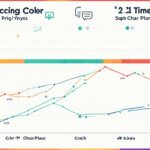Table of Contents
Welcome to our comprehensive guide on harnessing the power of ChatGPT for data analysis. In today’s data-driven landscape, the ability to analyze data effectively is crucial for making informed business decisions and gaining a competitive edge. With ChatGPT, a powerful language model created by OpenAI, data analysis becomes more accessible and efficient for both experts and non-experts alike.
ChatGPT is designed to understand and generate human-like text, making it a valuable tool for analyzing and interpreting data. Whether you’re an experienced data analyst or just starting your data analysis journey, ChatGPT can simplify complex tasks and provide meaningful insights through natural language conversation.
In this article, we will explore the importance of data analysis in business and delve into the capabilities of ChatGPT for data analysis. We will also discuss real-world use cases and provide a step-by-step tutorial on how to leverage ChatGPT for your data analysis needs.
So, if you’re ready to elevate your data analysis skills and unlock the potential of AI in data science, let’s dive into the world of ChatGPT and discover how it can revolutionize your data analysis process.
Understanding the Importance of Data Analysis for Business
Data analysis is vital for businesses to make informed decisions and gain a competitive edge in today’s fast-paced business landscape. It helps in extracting actionable insights from the vast amount of data generated by businesses every day. With data analysis, businesses can understand customer preferences, anticipate trends, identify areas for improvement, and optimize their operations. ChatGPT can be a valuable tool in this process, as it can simplify complex data analysis tasks and provide meaningful insights through natural language conversation.
By leveraging the power of ChatGPT for data analysis, businesses can unlock a whole new level of efficiency and effectiveness. Traditional data analysis methods often require technical expertise and extensive coding, making it challenging for non-experts to derive insights from data. However, with ChatGPT, the process becomes much more accessible and intuitive. Rather than relying on specialized software or complex algorithms, ChatGPT allows users to interact with data in a conversational manner, making data analysis less intimidating and more user-friendly.
One of the key advantages of using ChatGPT for data analysis is its ability to simplify complex tasks. The model can handle various data analysis techniques, such as exploratory data analysis, hypothesis testing, and data preprocessing. By engaging in a natural language conversation with ChatGPT, users can seamlessly navigate through these techniques and gain valuable insights without the need for extensive coding or technical knowledge. This simplifies the data analysis process and empowers individuals to make data-driven decisions faster and more effectively.
Furthermore, ChatGPT enhances the collaborative aspect of data analysis. It enables teamwork and knowledge sharing by allowing multiple users to engage in conversations around data analysis. Teams can collaborate on analyzing data, sharing findings, and collectively making informed decisions. This collaborative analytics feature not only streamlines the data analysis process but also fosters a culture of collaboration and innovation within organizations.
“ChatGPT’s ability to generate human-like text and understand complex queries makes it a valuable tool in the data analysis process.”
ChatGPT also brings a new level of interactivity to data analysis. The natural language conversation interface enables users to explore data, pose questions, and receive insights in real-time. This interactive approach not only saves time but also encourages users to ask deeper and more insightful questions, leading to more comprehensive data analysis and a better understanding of the underlying patterns and trends.
With its versatility and ease of use, ChatGPT can be leveraged across various industries and sectors. From marketing and finance to healthcare and manufacturing, businesses of all types and sizes can benefit from using ChatGPT for data analysis. It empowers decision-makers to analyze data more efficiently, gain valuable insights, and make informed decisions that drive business growth and success.
Benefits of using ChatGPT for Data Analysis:
- Simplifies complex data analysis tasks
- Enables non-experts to derive insights from data
- Promotes collaboration and teamwork
- Enhances interactivity and real-time insights
- Applicable in various industries and sectors
By harnessing the power of ChatGPT for data analysis, businesses can unlock a world of possibilities and gain a competitive edge. It revolutionizes the way data analysis is conducted, making it more accessible, user-friendly, and collaborative. Whether you’re a data scientist or a business professional, ChatGPT can be an invaluable tool in your data analysis toolkit, empowering you to extract meaningful insights and drive data-driven decision-making.
| Key Features | Benefits |
|---|---|
| Conversational interface | Enhanced user experience and ease of use |
| Seamless navigation of data analysis techniques | Simplifies complex tasks and reduces the learning curve |
| Collaborative analytics capabilities | Facilitates teamwork and knowledge sharing |
| Interactivity and real-time insights | Promotes deeper data exploration and comprehensive analysis |
| Applicable across multiple industries | Suits the data analysis needs of diverse sectors |
Exploring the Capabilities of ChatGPT for Data Analysis
ChatGPT, as an advanced language model, offers a wide range of capabilities that can be harnessed for data analysis. Its ability to understand and generate text makes it a valuable tool in analyzing and interpreting data through conversation. With ChatGPT, data analysts and professionals can leverage its flexibility and intelligence to simplify various data analysis tasks.
Leveraging ChatGPT for Exploratory Data Analysis
One of the key capabilities of ChatGPT is its ability to assist in exploratory data analysis. By conversing with ChatGPT, users can gain insights into their data, identify important patterns, and detect outliers. ChatGPT can help analysts explore data from different angles and provide meaningful interpretations, enabling efficient and comprehensive data exploration.
Information Summarization and Data Preprocessing
Another valuable application of ChatGPT in data analysis is information summarization. It can assist in condensing large volumes of data into concise summaries, making it easier to understand and extract key insights. Additionally, ChatGPT can aid in data preprocessing tasks such as data cleaning, formatting, and standardization, ensuring that the data is ready for further analysis.
Hypothesis Testing and Handling Large Datasets
ChatGPT can also be a useful resource in hypothesis testing, where it can generate hypotheses based on the provided data and domain knowledge. It can assist in performing statistical tests and drawing conclusions from the results. Furthermore, ChatGPT’s capability to handle large datasets enables analysts to efficiently analyze and derive valuable insights from extensive data collections.
Collaboration Analytics and Sentiment Analysis
In a collaborative environment, ChatGPT can facilitate collaboration analytics by generating insights from multiple data sources and providing recommendations for collaborative decision-making. Moreover, it can analyze sentiment in text data, allowing businesses to gain insights into customer opinions, feedback, and preferences.
Analyzing Excel Formulas and Generating SQL Code Snippets
ChatGPT’s language understanding capabilities extend to analyzing Excel formulas and generating SQL code snippets. This makes it a valuable tool for data analysts who need to work with spreadsheets or databases. By conversing with ChatGPT, users can receive assistance in Excel formula debugging, formula suggestions, or generating SQL queries.
Through its powerful language generation and comprehension abilities, ChatGPT offers a versatile and intelligent solution for data analysis tasks. By leveraging ChatGPT, professionals can unlock new possibilities and streamline their data analysis processes while deriving meaningful insights from their data.
Realizing the Potential of ChatGPT in Data Analysis: Use Cases
ChatGPT offers a wide range of applications in data analysis, empowering businesses and individuals to extract valuable insights and make data-driven decisions. By leveraging ChatGPT’s powerful capabilities, users can streamline their data analysis process and enhance their analytical techniques. Here are some real-world use cases where ChatGPT proves to be a valuable tool:
- Exploratory Data Analysis and Data Visualization: ChatGPT can assist in exploring and visualizing data, providing interactive conversation-based insights for better understanding and analysis.
- Information Summarization: ChatGPT can summarize large amounts of data into concise and meaningful summaries, saving time and effort.
- Data Preprocessing and Cleaning: With ChatGPT’s conversational capabilities, it can help in preprocessing and cleaning datasets by identifying anomalies, inconsistencies, and missing values.
- Employee Feedback Analysis: ChatGPT can analyze and interpret employee feedback, enabling organizations to gain valuable insights into employee sentiment and areas for improvement.
- Hypothesis Testing: By interacting with ChatGPT, users can test hypotheses and perform statistical analysis, simplifying the process and providing accurate results.
- Handling Large Datasets: ChatGPT can efficiently handle large datasets by providing relevant insights and recommendations to manage and process the data effectively.
- Collaboration Analytics: ChatGPT can facilitate collaboration among data analysts by generating ideas, suggestions, and interactive discussions based on the data.
- Sentiment Analysis: With its language understanding capabilities, ChatGPT can analyze text data and provide sentiment analysis, helping businesses understand customer opinions and feedback.
- Analyzing Excel Formulas: ChatGPT can assist in analyzing and validating complex Excel formulas, ensuring accuracy in data processing and analysis.
- Generating SQL Code Snippets: ChatGPT can generate SQL code snippets based on data requirements, simplifying database query and analysis.
These use cases highlight the versatility of ChatGPT in various aspects of data analysis. By generating insights, providing recommendations, and simplifying complex tasks, ChatGPT significantly enhances the data analysis experience.
Case Study: Employee Feedback Analysis
“We implemented ChatGPT to analyze our employee feedback data, and the results have been outstanding. ChatGPT assists us in understanding employee sentiments, identifying recurring themes, and generating actionable insights. This has empowered our organization to refine our employee engagement strategies and foster a positive work culture.” – Emma Johnson, HR Manager at XYZ Corporation
As the case study above demonstrates, ChatGPT enables organizations to gain valuable insights from employee feedback, improving employee satisfaction and overall organizational performance.
Use Cases of ChatGPT in Data Analysis
| Use Cases | Benefits |
|---|---|
| Exploratory Data Analysis and Data Visualization | Interactive insights and enhanced understanding of data |
| Information Summarization | Time-saving and concise data summaries |
| Data Preprocessing and Cleaning | Efficient data cleaning and error identification |
| Employee Feedback Analysis | Insights into employee sentiment and areas for improvement |
| Hypothesis Testing | Streamlined statistical analysis and accurate results |
| Handling Large Datasets | Efficient management and processing of large datasets |
| Collaboration Analytics | Facilitation of collaborative data analysis processes |
| Sentiment Analysis | Understanding customer opinions and feedback |
| Analyzing Excel Formulas | Validation and accuracy in Excel formula analysis |
| Generating SQL Code Snippets | Simplification of database query and analysis |

Using ChatGPT for Data Analysis: A Step-by-Step Tutorial
In this section, we will provide a comprehensive step-by-step tutorial on how to leverage ChatGPT for data analysis. By following these instructions, you’ll be able to unlock the potential of this powerful tool and enhance your data analysis capabilities.
1. Activating ChatGPT Features
To begin, ensure that you have access to ChatGPT and activate the relevant data analysis features. This will enable ChatGPT to understand and respond to data-related queries effectively.
2. Uploading Data into ChatGPT
Next, you’ll need to prepare your data for analysis. Upload your dataset into the ChatGPT platform, ensuring that it is compatible with the supported file formats. This step is crucial as it provides the foundation for your data analysis process.
3. Utilizing Data Analysis Prompts and Visualization Capabilities
Once your data is uploaded, you can begin interacting with ChatGPT to extract valuable insights. Pose data analysis prompts or questions in a conversational manner, and ChatGPT will generate responses that shed light on your data. Additionally, take advantage of ChatGPT’s visualization capabilities to enhance your understanding of the data through charts, graphs, and other visual representations.
4. Interpreting the Results and Providing Recommendations
After receiving responses from ChatGPT, it’s essential to interpret the results accurately. Analyze the generated insights and identify patterns, trends, or anomalies within your data. Based on these findings, you can then formulate informed recommendations or make data-driven decisions to drive your business forward.
5. Verifying Results and Considering Limitations
While ChatGPT is a powerful tool for data analysis, it’s crucial to verify the generated results and consider the model’s limitations. Cross-reference the insights with other analysis methods or domain knowledge to ensure accuracy. Keep in mind that ChatGPT may not always provide the most comprehensive or entirely foolproof analysis due to the nature of the model.
By following these step-by-step instructions, you’ll be able to effectively utilize ChatGPT for data analysis. The combination of natural language conversation and AI-powered insights will simplify your data analysis process and empower you to make informed decisions based on the generated insights.
Next, we will explore a range of real-world use cases where ChatGPT can be applied in data analysis to generate meaningful insights and drive business growth.
Conclusion
ChatGPT brings forth exciting possibilities for data analysis, enabling individuals to analyze and interpret data through natural language conversation. Its ability to generate human-like text and comprehend complex queries establishes it as a valuable tool in the data analysis process. By harnessing the power of ChatGPT, individuals can unlock the potential of AI in data science and enhance their analytical skills, elevating the efficiency and accuracy of their data analysis endeavors.
To fully leverage the capabilities of ChatGPT for data analysis, it is crucial to continuously explore new use cases and stay updated with the advancements in the field. As the technology continues to evolve rapidly, staying informed about the latest features and enhancements of ChatGPT will ensure that individuals maximize its potential and benefit from the most effective data analysis techniques. The integration of ChatGPT into data analysis workflows can revolutionize the way businesses and professionals analyze and derive insights from their data.
As the field of data analysis continues to grow in importance, incorporating tools like ChatGPT into the analytical process will become increasingly beneficial. The natural language conversation aspect of ChatGPT makes it more accessible and user-friendly, allowing individuals without extensive technical knowledge to perform complex data analysis tasks effortlessly. Moving forward, the widespread adoption and understanding of ChatGPT for data analysis can lead to more informed decision-making, improved business strategies, and enhanced insights derived from data.
FAQ
How can I use ChatGPT for data analysis?
ChatGPT can be used for data analysis by leveraging its natural language conversation capabilities. It can assist in tasks such as exploratory data analysis, information summarization, data preprocessing, hypothesis testing, collaboration analytics, sentiment analysis, analyzing Excel formulas, and generating SQL code snippets.
What are some real-world use cases where ChatGPT can be applied for data analysis?
Some examples of real-world use cases for ChatGPT in data analysis include exploratory data analysis and data visualization, information summarization, data preprocessing and cleaning, employee feedback analysis, hypothesis testing, handling large datasets, collaboration analytics, sentiment analysis, analyzing Excel formulas, and generating SQL code snippets.
How can I use ChatGPT for data analysis effectively?
To use ChatGPT effectively for data analysis, you should activate its features, upload data into the model, utilize data analysis prompts and visualization capabilities, interpret the results, and consider the limitations of the model. It is also important to verify the results and continuously explore new use cases to fully leverage ChatGPT’s capabilities.
How can ChatGPT enhance my data analysis skills?
ChatGPT can enhance your data analysis skills by providing insights, recommendations, and generating human-like text to simplify complex queries. By leveraging ChatGPT’s capabilities, you can unlock the potential of AI in data science and gain a better understanding of your data through natural language conversation.
What are the limitations of using ChatGPT for data analysis?
While ChatGPT is a powerful tool for data analysis, it is important to consider its limitations. The model’s responses are generated based on trained patterns and may not always reflect accurate analysis. It is crucial to verify the results independently and understand that ChatGPT may not be able to handle all complex analysis tasks. Continuous learning and staying updated on advancements in ChatGPT are essential for effectively leveraging its capabilities.













